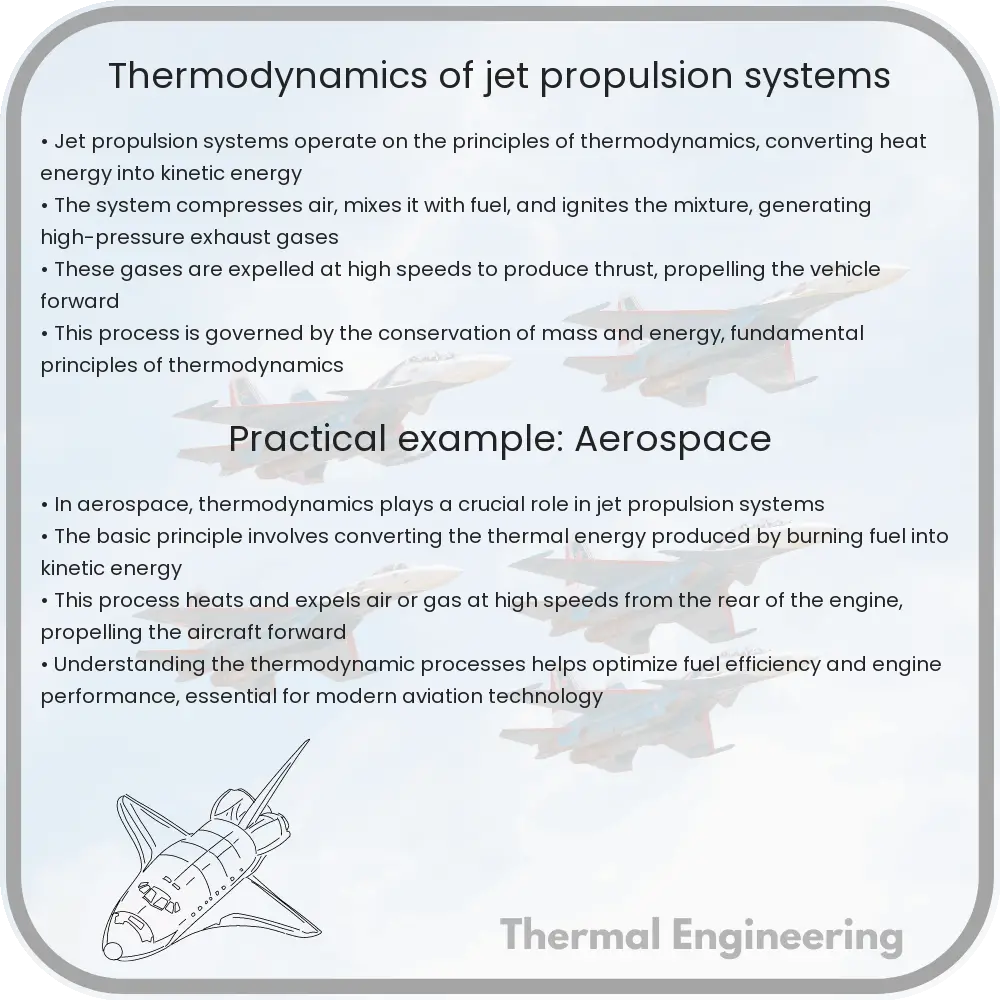Learn about the thermodynamics principles that power jet propulsion systems in aircraft and space vehicles.

Understanding the Thermodynamics of Jet Propulsion Systems
Jet propulsion systems are a critical component in various types of aircraft, including commercial airliners, military jets, and space vehicles. The fundamental science that enables these systems to work so effectively is thermodynamics, the branch of physics that deals with heat and temperature and their relation to energy and work. In this article, we will explore the basic thermodynamic principles that govern jet propulsion systems and how they are implemented in engineering design.
Basic Principles of Thermodynamics in Jet Engines
The operation of a jet engine involves converting the chemical energy stored in fuel into mechanical energy in the form of thrust. This process is governed by several key principles in thermodynamics:
- First Law of Thermodynamics: This law, also known as the law of energy conservation, states that energy cannot be created or destroyed, only transferred or changed in form. In jet engines, chemical energy from the fuel is converted into thermal energy by combustion and then into kinetic energy as the gases are expelled at high speed to produce thrust.
- Second Law of Thermodynamics: This law states that the entropy (degree of disorder) of an isolated system always increases over time. In practical terms, this means that any energy conversion process, including those in a jet engine, is not 100% efficient. Some energy is always lost, usually as waste heat.
- The concept of cycles: Jet engines operate on the basis of thermodynamic cycles, with the Brayton cycle being the most common. This cycle involves adiabatic compression, isobaric (constant pressure) combustion, and adiabatic expansion.
The Brayton Cycle Explained
The Brayton cycle is the fundamental cycle underlying most modern jet propulsion systems. It consists of the following stages:
- Intake and Compression: Ambient air is drawn into the engine and compressed by the compressor, increasing its pressure and temperature and decreasing its volume.
- Combustion: Fuel is injected into the compressed air, and the mixture is ignited. The combustion generates a high-temperature, high-pressure gas.
- Expansion and Exhaust: The high-pressure gas expands through the turbine, which extracts energy to run the compressor. The gas then exits the engine at high speed through the exhaust, providing thrust.
The efficiency of this cycle is influenced by several factors, including the pressure ratio (the ratio of the pressure at the compressor outlet to that at the inlet) and the turbine inlet temperature. Higher pressure ratios and higher temperatures generally lead to increased efficiency but also pose greater technical challenges in terms of materials and construction.
Engineering Applications and Innovations
In the realm of engineering, applying the principles of thermodynamics to jet propulsion involves continuous innovation and improvement. Advances in materials science allow for higher temperature and pressure conditions within the engine, improving efficiency. Computational fluid dynamics (CFD) and other simulation tools provide engineers with the ability to optimize engine designs before physical prototypes are built.
Moreover, modern engineering efforts also focus on sustainability, aiming to reduce the environmental impact of jet propulsion. This includes developing engines that burn fuel more completely to reduce emissions and researching alternative fuels that are more environmentally friendly.
In conclusion, the thermodynamics of jet propulsion is a vibrant area of engineering that combines principles of physics with sophisticated technological design. Understanding these principles not only helps us appreciate the complexities of modern air travel and space exploration but also drives continuous advancements in the efficiency and sustainability of these crucial systems.